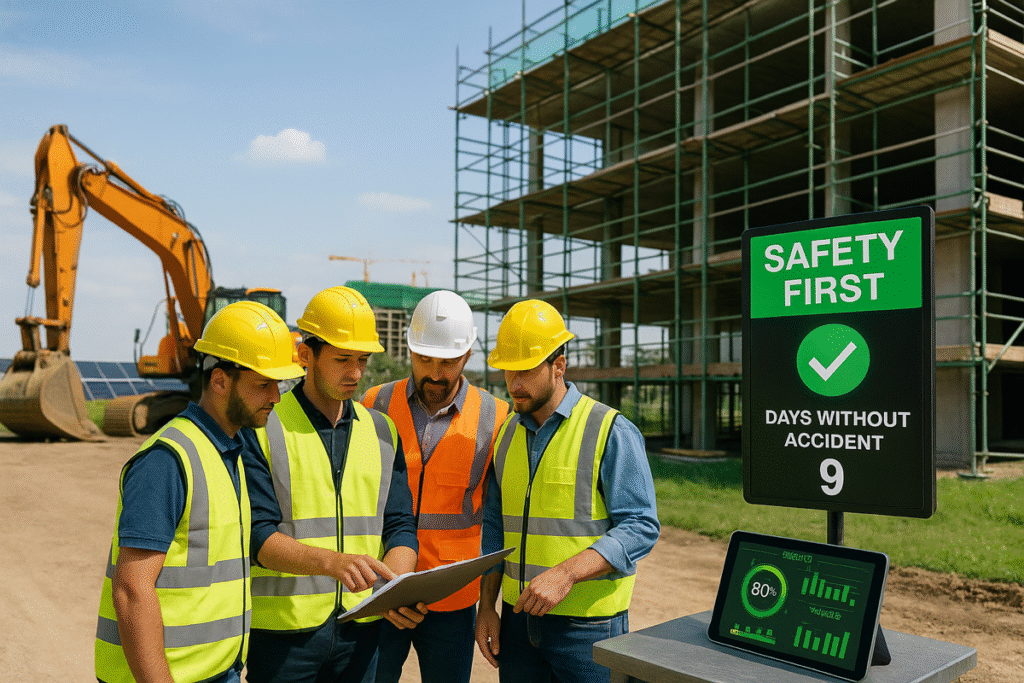
Integrating Sustainability Goals into Construction Safety Planning: A Strategic Necessity for Modern Industry

As environmental pressures intensify and regulatory demands evolve, construction companies can no longer afford to treat sustainability and safety as separate silos. The strategic integration of sustainability goals into construction safety planning is not just a forward-thinking approach it is a compliance imperative, a reputational asset, and a pathway to long-term operational resilience.
Construction has traditionally been resource-intensive, contributing significantly to global carbon emissions and occupational hazards. According to the U.S. Environmental Protection Agency, the building sector contributes to nearly 39% of carbon dioxide emissions globally, while construction activities remain among the top five most dangerous professions in the U.S., as outlined by the Bureau of Labor Statistics (U.S. EPA, 2024). The combination of these statistics highlights the urgent need for unified policies that mitigate environmental degradation and enhance worker safety.
A key concept gaining traction is “Prevention through Design” (PtD), promoted by the National Institute for Occupational Safety and Health. PtD encourages integrating hazard mitigation during the design phase avoiding risks before a shovel even touches the ground (Prevention through Design, 2024). This strategy directly contributes to both reduced material waste and fewer injury exposures, allowing companies to align their sustainability and safety goals without compromise.
In the transportation industry, the overlap of sustainability and safety is especially critical. From railroads to highways, integrating environmental safeguards like low-emission machinery and clean fuel policies with safe operational procedures can reduce accident rates and operational costs. The U.S. Department of Transportation’s Sustainability Plan emphasizes the adoption of electric and hybrid fleets, paired with rigorous driver training and preventive maintenance programs ensuring reduced emissions and improved fleet safety (Sustainability Plan, 2023).
The construction industry faces similar cross-pressures. Jobsite hazards such as silica dust exposure, heat stress, and noise pollution can be mitigated by implementing eco-friendly construction materials and green building certifications like LEED and WELL. These standards encourage not only energy-efficient practices but also layouts that enhance airflow, light exposure, and worker wellbeing (U.S. Green Building Council, 2023). The Occupational Safety and Health Administration (OSHA) supports such dual-purpose strategies, emphasizing that sustainable methods such as recycling demolition debris should not undermine compliance with fall protection or respiratory standards (Construction Industry, 2024).
For the general industry, integrating sustainable operations into safety processes is crucial to reducing incident severity while supporting ESG (Environmental, Social, Governance) targets. Data from the National Safety Council suggests that workplaces that prioritize both environmental and human safety experience up to 50% fewer lost-time injuries compared to those that treat these areas separately (NSC, 2023).
In the environmental industry, where hazardous waste, chemical handling, and emissions are daily concerns, coordinated planning around sustainability and safety ensures regulatory compliance and community trust. EPA’s updated guidelines on stormwater management now include worker safety practices during containment system installations, exemplifying this integration (Stormwater Discharges from Construction Activities, 2024).
From a compliance standpoint, these practices relate to OSHA’s four key safety areas fall protection, hazard communication, scaffolding, and respiratory protection. Sustainable material choices, controlled deconstruction, and on-site air filtration systems all contribute to minimizing these risks while meeting EPA standards. For example, using modular or prefabricated components reduces on-site work at heights, a leading cause of fatalities in construction (Fall Protection, 2024).
Ten safety practices that support sustainable integration include lifecycle hazard assessment, green procurement, renewable energy deployment, water conservation planning, real-time dust monitoring, energy-efficient PPE, low-VOC adhesives, recyclable barrier materials, digital permit-to-work systems, and comprehensive worker training in both EHS and sustainability protocols. These techniques are increasingly embedded into digital tools such as Building Information Modeling (BIM) and Construction Management Software with sustainability modules (PlanRadar, 2024).
However, integrating sustainability into safety planning still faces challenges. A 2023 survey conducted by Dodge Construction Network found that only 32% of U.S. contractors formally link sustainability metrics with safety KPIs. This gap represents both a risk and an opportunity. Organizations that fail to unify these domains risk non-compliance with new federal ESG reporting rules and increasing scrutiny from investors and clients (Dodge Construction Network, 2023).
Key Safety LLC is actively addressing this need by supporting construction, general industry, transportation, and environmental clients with integrated EHS consulting services. Our offerings include development of Safety and Environmental Management Systems (SEMS), site-specific risk assessments that account for environmental conditions, and training programs tailored to sustainable safety practices. Whether your goal is to achieve ISO 14001/45001 certification or prepare for upcoming ESG disclosures, our consultants guide you from planning through execution.
In the long term, the fusion of safety and sustainability results in safer jobsites, lower operational costs, and stronger reputations. These outcomes support the United Nations Sustainable Development Goals (SDGs), particularly Goal 8 (Decent Work and Economic Growth) and Goal 13 (Climate Action), reinforcing a company’s public image and internal culture.
For emerging professionals, understanding the links between sustainable development and safety planning can be a key differentiator in your career. Clients and employers are seeking partners who think beyond compliance those who prioritize the planet and people simultaneously.
Subscribe to our newsletter to get the latest updates, expert insights, and best practices in integrated sustainability and safety planning. Discover how Key Safety LLC can support your business in staying compliant, efficient, and future-ready.
References
Dodge Construction Network. (2023). Safety management in the construction industry 2023. https://www.construction.com/resource/safety-management-in-the-construction-industry-2023/
Environmental Protection Agency. (2024). Stormwater discharges from construction activities. https://www.epa.gov/npdes/stormwater-discharges-construction-activities
National Institute for Occupational Safety and Health. (2023). Prevention through Design. https://www.cdc.gov/niosh/ptd/about/?CDC_AAref_Val=https://www.cdc.gov/niosh/topics/ptd/default.html
PlanRadar. (2024, August 9). BIM for green building: Enhancing sustainability through digital design. https://www.planradar.com/sg/bim-green-building-sustainability-digital-design/
National Safety Council. (2023, September 14). NSC groundbreaking study on New Value of Safety: Transforming modern workplace health & wellbeing. https://www.nsc.org/newsroom/nsc-releases-groundbreaking-study-nvos
Occupational Safety and Health Administration. (2024). Fall protection. https://www.osha.gov/fall-protection
Occupational Safety and Health Administration. (2024). Construction. https://www.osha.gov/construction
U.S. Department of Transportation. (2022). Sustainability Plan. https://www.sustainability.gov/pdfs/dot-2022-sustainability-plan.pdf
U.S. Green Building Council. (2023). LEED Credits for Occupational Health. https://www.usgbc.org/credits/new-construction/v4
Comments:

